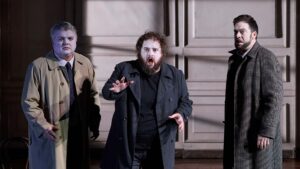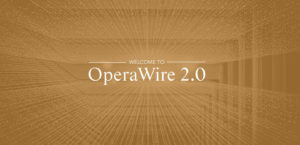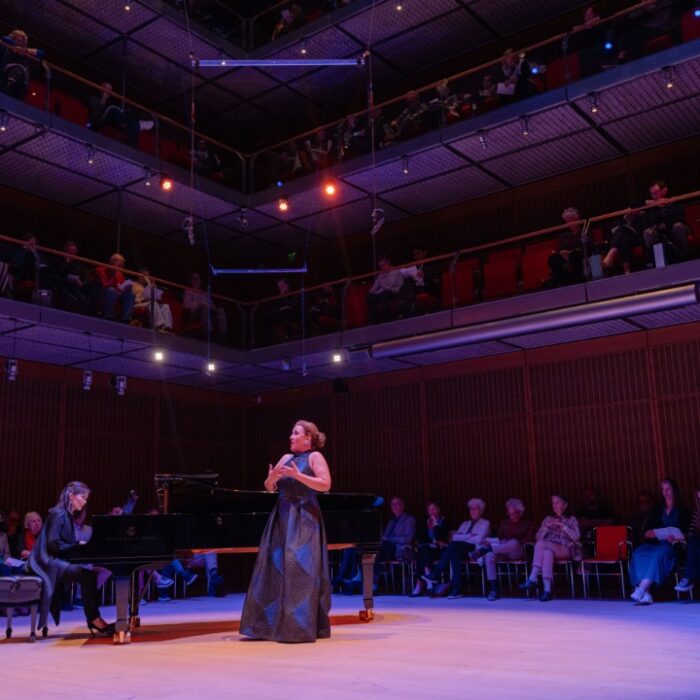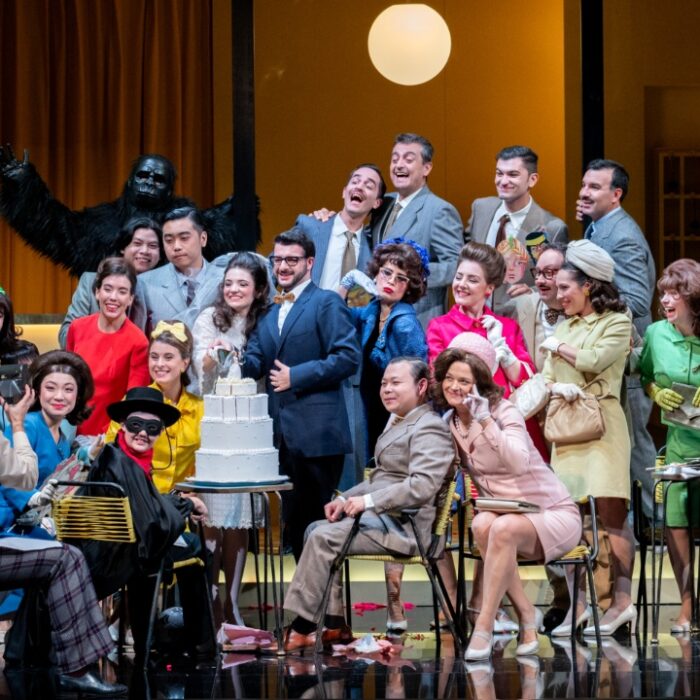
Opera Australia 2024 Review: Hamlet
By Zoltan Szabo(Credit: Keith Saunders)
It was commissioned by and premiered at the Glyndebourne Festival in 2017. Then new cities followed suit every year (apart from the horrid COVID-infected era): Adelaide Festival (2018), a new production in Cologne, Germany (2019), the massive success at the Metropolitan Opera of New York (2022) and the Bavarian State Opera in München (2023). Finally, after seven years, leading Australian composer, Brett Dean’s opera, “Hamlet,” has seen its premiere in the iconic Sydney Opera House, truly a momentous occasion.
Success is an elusive word but the impact of a significant contemporary opera on its audience hinges on several artistic factors: the creation of the text (or libretto) and the music, followed by the staging (apart from the direction, also the costume, set and lightning design), and finally the vocal skills and stagecraft of the singers supported by the orchestra and overseen by the conductor.
All the stars aligned in this case (as they did, reportedly, in all previous productions) and the audience, braving the cold, windy Australian winter night (sic!) was rewarded by a high-octane historical achievement.
Deconstructing Shakespeare
Those who arrived with a solid understanding of Shakespeare’s longest drama, may have been confused very early on, as Hamlet’s first words were: “…or not to be” (citing the play’s Act three soliloquy). Librettist, Matthew Jocelyn, freely reconstructed (or deconstructed?) the original drama, leaving out about eighty percent of the lines and reordering the various scenes, such as the Ghost scene in the opera being immediately followed by the first appearance of Rosencrantz and Guildenstern. Similar liberties, if not to the same extent, were permissible in 19th-century Shakespeare adaptations, for example when Arrigo Boito penned two brilliant librettos for Verdi’s Otello and Falstaff; at any rate, Jocelyn’s text has its own dramatic arc, which must be respected.
On a few occasions though, overwriting Shakespeare’s proportions and structure did seem to claim some victims. The role of Horatio (sang lovingly by Samuel Dundas) comes to mind: he is Hamlet’s only confidant and close friend, offsetting the prince’s increasing mental disturbance by his consistently reasonable, rather than emotional commentary. In Jocelyn/Dean’s version, he became a peripheral figure with little character and even less lines; therefore, his touchingly poignant farewell to his dying friend in the final minutes of the opera seemed dramatically unprepared.
Inventive Musical Language
Already with his first opera, Bliss (2010), Brett Dean proved himself to be a dramatically focussed, enormously imaginative composer. His operatic style has matured further with the passing years. His writing is both inspired and intellectual, emotive and eloquent. His score demonstrates extremely careful planning in its instrumentation, in the versatile use of compositorial tools and in the composer’s profound understanding of what works well in an operatic environment. The creative use of his chorus, as an active, commenting part of the evolving drama in the large tableaux (there is also a “semi-chorus” employed as a quasi-extension of the orchestra) is beautifully offset by the inventive accompaniment of the play-within-a-play almost entirely by a solo accordion (in James Crabb’s astoundingly accomplished performance).
It would be nigh impossible to form a fully reliable opinion of the merits of this opera based on one single performance. Nonetheless, the near-constant busyness of the score may be overwhelming to many audience members, connoisseur or amateur. Dean regularly employs Sprechstimme (half singing, half speaking with a fixed rhythm) and quarter tones as part of his musical vocabulary. They make his score varied and colourful but less easy to follow or appreciate, begging the question: should a 21st-century composition consider aesthetic beauty an essential part of its appeal? (There are plenty of examples for an affirmative answer.)
While there are certainly slower and quieter sections in the music (often attached to the role of Ophelia), the dense intensity of the orchestral writing rarely allows for repose, or calmer, introspective moments. In a dramatic work lasting for about three hours, conceived in a mostly atonal musical style, some memorable melodic lines attached to the protagonists would help the listeners to sympathize with and remember them (“Wir arme Leut…!” – sang heartbreakingly Alban Berg’s “Wozzeck” in a very modern opera, albeit almost a hundred years ago), or perhaps, brief, recurring melodic fragments to identify them and their unique personalities (a tool, called Leitmotif, regularly used by opera composers in the past).
Starry Cast
This production, as well as most of the previous ones of the opera featured British tenor, Allan Clayton, as the eponymous prince. His all-round splendid concept and performance alone was well worth the entry fee. Being supremely comfortable with Dean’s complex writing, he articulated and sang his lines with clarity and conviction, relying on his excellent stage presence, warm tone and attractive vibrato. He began the opera as a shadowy black ghost walking around at the pompous party celebrating the new king and his (Hamlet’s, that is) mother’s nuptials, a subtle nod to his father, the “real” Ghost of the play.
Both the King (Rod Gilfry) and his new wife, Gertrude (Catherine Carby) were reassuringly confident singing their parts. Their portrayal of this calculating, power hungry pair was not entirely convincing though. For such a villainous character as Claudius, Gilfry’s movements were too timorous, and his voice would have benefited from more authority. Carby was a late and brave replacement for a cast member sadly deceased, which might explain the limited expression in her voice and body language. Jud Arthur’s stately bass gave nobility to the role of the Ghost of old Hamlet and some comic relief in the somewhat underwhelming Yorick scene.
Not many would think of the vile character of Polonius as comical, yet Kanen Breen emphasised many, almost parodistic gestures in his forming of the counsellor to the new king. Similarly to the rest of the cast, his preparation and presentation of his difficult part was thorough, though with an erratic, conniving father like him, it would be hard not to empathise with the many problems that his children, Ophelia and Laertes, faced.
As Laertes, Nicholas Jones made the most of the innocent victim of Claudius’s murderous manipulation, growing into near-hero status in the excellently choreographed sword fight at the end.
The role of Ophelia was famously written with soprano, Barbara Hannigan, world-wide expert of contemporary opera, in mind. Her part is, accordingly, fiendishly difficult, making the work of all later Ophelia’s maddeningly trying (pun intended). Lorina Gore had already proven herself as the Adelaide Festival’s Ophelia, and now she reprised that role. In Act one, she seemed to be hesitant in pitch and expression, but her great scene at the beginning of Act two was fully convincing.
The odd couple of this drama, the King’s bumbling spies, Rosencrantz and Guildenstern, were performed by Russell Harcourt and Christopher Lowrey (the latter having already sang the part at Glyndebourne and the Metropolitan Opera). Bearing considerable similarities to the comical nieces in Britten’s “Peter Grimes,” they continually repeated and imitated each other, being highly ineffective, and like most other protagonists, ended up dead. Their parts, as yet another inspired idea by the composer, were written for countertenor voices. This worked excellently when only the two of them were singing but seemed less powerful in ensembles.
The orchestra was impressively prepared and the chorus sang with aplomb and remarkable accuracy; nowhere with near as much conviction as at the opening of Act two (people’s power: “Laertes shall be king!”, another strong resonance with Peter Grimes). That scene, with the chorus lining up on the sides of the auditorium next to the seated audience, was just one of the many imaginatively conceived ideas of Australian director, Neil Armfield, in charge since the Glyndebourne premiere and for most later productions. His directorial work proved (does it have to be proven?) that great acting can go hand in hand with terrific singing on an opera stage. Amongst set designer, Ralph Myers’s effortlessly moving massive walls and in costume designer, Alice Babidge’s timeless eveningwear, every movement and every gesture made good theatrical sense in this production. Sadly rare on an operatic stage, humorous elements kept lightening up the drama and the flow of the action never ceased to be eye-catching.
High accolades are due to the last but certainly not least essential member of the creative team. Tim Anderson, conducting Dean’s complex score for the first time, stood assuredly in front of the large performing forces. Not only did he give precise indications for the difficult entries to all, but he kept the stream of the music elegantly, never failing to manage the intricate balances between stage and orchestra allowing the Dane prince’s story to evolve and Dean’s music to shine, creating a momentous occasion indeed.



